Out of Context: Understanding Student Learning Through Museum Studies
In Brief:
How can we maximize library spaces and displays to support information literacy and critical thinking? How can we re-envision student learning in the ways that museums facilitate experiential learning and measure visitor engagement? This case study uses a theoretical framework, Falk and Dierking’s Contextual Model of Learning, to examine and analyze student responses to the Context Library Series, a series of interdisciplinary art installations. At the intersection of information literacy and museum visitor studies, we see that the context in which students learn best is often in line with best practices of museums. We find these practices can be applied in and embraced by libraries in ways that are not limited to exhibits, to further support the experience, engagement, and learning of students. Content analysis of student responses to the Context Library Series at California State University San Marcos serves as a model to understand how students learn outside the classroom and how to measure this learning in creative, nontraditional ways.
By Melanie Chu
Introduction
Academic library programs and collections are often seen as peripheral, removed from the teaching and learning of a university, in the netherland somewhere between an instructional department and a student support service. Similarly, artwork and exhibits occupy a liminal zone of libraries, aesthetically pleasing but often lacking real purpose or meaning beyond background decoration. And yet, libraries are uniquely situated as common learning spaces for self-directed inquiry tied to the curriculum; and librarians (“simultaneously insiders and outsiders of the classroom and of the academic disciplines in which they specialize”) are uniquely positioned to act as mediators of the curriculum. ((See Jean D. Van Deusen, “The School Library Media Specialist as a Member of the Teaching Team: ‘Insider’ and ‘Outsider,’” Journal of Curriculum & Supervision 11, no. 3 (1996):231; Michelle H. Simmons, “Librarians as Disciplinary Discourse Mediators: Using Genre Theory to Move Toward Critical Information Literacy.” portal: Libraries and the Academy 5, no. 3 (2005): 298.)) While close curricular ties are the basis for many collection development policies, those same imperatives are less apparent in the spaces, exhibits, and programs of an academic library.
The Context Library Series at California State University San Marcos transforms a common learning space with experiential, curricularly-integrated art installations. A museum-based theoretical framework, Falk and Dierking’s Contextual Model of Learning, is used to examine and analyze student responses to these exhibits. At the intersection of information literacy and museum visitor studies, we see that the context in which students learn best is often in line with best practices of museums. We find these practices can be applied in and embraced by libraries in ways that are not limited to exhibits, to further support the experience, engagement, and learning of students. The Contextual Model of Learning provides a useful schema to address two questions: more broadly (1) what is the role of art and exhibit spaces in academic libraries? And more specifically (2) how do library exhibits impact student learning? This article aims to broaden and shift the conversation of student learning by applying ideas from the existing literature of museum studies, an incredibly relevant, yet underutilized, understanding of the learning that occurs in a museum setting.
About California State University San Marcos and the Context Library Series
California State University San Marcos (CSUSM) is a mid-sized public institution that prides itself on accessible higher education, and its student demographics are representative of the region. As of fall 2014, nearly half of first-year students were the first in their families to attend college, and 44% of the 12,000 undergraduates were underrepresented minority students. ((California State University San Marcos, “2015 Institutional Report,” in CSUSM Western Association of Schools & Colleges (WASC). http://www.csusm.edu/wasc/institutionalreport.html)) For many CSUSM students, the library’s gallery may very well be their first encounter with a formal art installation. With nearly thirty exhibits to draw on from its fourteen-year history, the Context Library Series (CLS) provides a rich dataset to provide insight into the impact of library exhibits and common learning spaces on student learning. Like the library’s physical and digital collections— the books, periodicals, databases, and media of the library — CLS provides access to content that supplements and supports student learning and research. Unmediated raw materials, both collections and artwork, have the potential to engage students. However, the curation of these materials elevates the library’s role in enhancing the learning process and “critical habits of mind” we seek to cultivate in students. ((Jennifer Fletcher, “Critical Habits of Mind: Exposing the Process of Development,” Liberal Education 99, no. 1 (Winter 2013).)) Analysis of student work within educational theory helps determine the mechanisms in which student learning takes place.
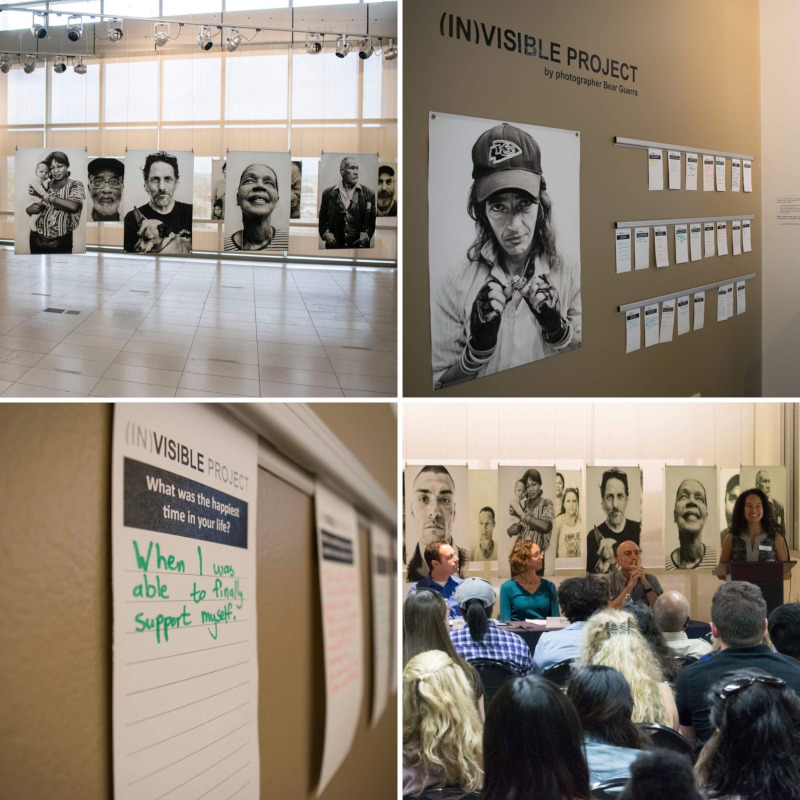
(In)Visible Project (fall 2016) installation, exhibit-related activity, and panel discussion in CSUSM Library’s lobby-turned-gallery.
Lest readers think a museum-quality space is required to implement a program like CLS, this library gallery might otherwise be described as the lobby of an academic library. Adjacent to the building’s stairwell and elevators, the main gallery is two stories tall with an approximate footprint of 775 square feet; its moveable walls can be reconfigured into various layouts. Including the neighboring walls of the Research Help area, there is over 1000 square feet of surface area for installing artwork. The gallery’s centralized location, its high volume of foot traffic, and the limits of the gallery itself—limited financial resources and lack of security surveillance or climate control, for example—prohibit the collecting, displaying, and preserving of fine art objects like some museums. Each exhibit is on display in the library for several months (e.g., February-May, September-December), serving as a visual and interdisciplinary representation of the curriculum for classes throughout the course of the semester. The extended display time frame serves a secondary goal of the series: it engages the local community with the campus by offering numerous programming opportunities such as artist talks, guided exhibition tours, and thematically-related lectures.
The examples and assessments highlighted here can be adapted and implemented in a variety of libraries, particularly academic, school, and public settings with an educational mission. This case study is relevant to readers from all settings who are interested in challenging the notions of what can occur in a library, how outreach can be assessed, and how available spaces can be utilized. Moreover, this piece shows how the library is part and parcel to curricular development and student experience, thus breaking down institutional walls, as well as creating a museum without walls. The literature and theoretical framework that follow draw from several fields outside library science, primarily museum visitor studies, as well as learning and educational theories.
Literature Review
Exhibitions in Libraries, and Library as Museum
Some of the earliest art collections were established within universities for the purpose of study, such as Oxford’s Ashmolean Museum (est. 1683), supporting the “wider cultural role of the university in feeding the minds of students and staff far beyond the increasingly narrow limits of their studies and research.” ((Patrick J. Boylan, “Universities and Museums: Past, Present and Future,” Museum Management and Curatorship 18, no. 1 (1999): 43.)) Over time, university art collections became more niche and accessible to limited groups of scholars. Smaller exhibitions continued in libraries to serve as a teaching tool, simply “organizing materials around a theme as a self-learning experience.” ((Andrew Dutka, Sherman Hayes, and Jerry Parnell, “The Surprise Part of a Librarian’s Life: Exhibition Design and Preparation Course,” College & Research Library News 63, no. 1 (2002): 19.)) Today, most university libraries use displays only to highlight their own materials and special collections; in a survey of the Association of Research Libraries, all but one of the 79 respondents reported they have exhibitions using their collections. ((Sean Swanick, Sharon Rankin, and Melinda Reinhart, “Curating Exhibitions in Academic Libraries: Practical Steps,” Practical Academic Librarianship 5 (2015): 5.)) Library exhibits are an area of untapped potential. Kam observes that in some ways, librarians are in a position to exhibit more freely than their colleagues in museums and galleries, and in doing so, “we exercise our role as key cultural players in society while also reinforcing our institutional identities.” ((D. Vanessa Kam, “On Collecting and Exhibiting Art Objects in Libraries, Archives, and Research Institutes,” Art Documentation: Bulletin of the Art Libraries Society of North America 20, no. 2 (2001): 14.)) Even when libraries have artwork integrated into their spaces, librarians may not be curating exhibits the same way we curate curricularly relevant collections. Why would artwork in a library be relegated to architectural and interior design when it serves a higher instructional purpose? Given the prevalence of collection-specific library displays, there is a notable lack of research examining and assessing the utilization of displays in academic libraries.
To understand the role and impact of CLS, it is more helpful to characterize the library gallery as a (small) museum and to frame student learning within visitor studies. Bitgood and Shettel posit: “Not only can visitor evaluation identify the cognitive and affective outcomes of an educational exhibit or program, but it provides the tools for improving these outcomes.” ((Steven Bitgood and Harris H. Shettel, “An Overview of Visitor Studies,” Journal of Museum Education 21, no. 3 (November 2015): 8.)) Brown and Power differentiate between libraries as concerned with information and museums as concerned with objects ((Mary E. Brown and Rebecca Power, Exhibits in Libraries: A Practical Guide (Jefferson, NC: McFarland, 2006), 15.)), but this distinction is superficial and perhaps outdated. The library, like a museum, is situated as a public space, and “as such, constitutes a forum for meetings, dialogue, public debate, and discussion.” ((Diana A. Pinus, “Look Again! Planning an Exhibition with Social Interaction in Mind.” Journal of Museum Education 25, no. 1/2 (2000): 21.)) And museums, like libraries, face increasing pressure “from community stakeholders and from funders to develop a closer, more meaningful relationship within the community.” ((Carrie Herrick, et al., “Building Responsive Museums A Discussion Framework,” in The Learning Coalition (June 2009). https://members.museumsontario.ca/sites/default/files/members/buildingresponsivemuseumspolicyandplanning.pdf)) Per Worts, museums have the potential “to act as mirrors (both literal and symbolic) that engage us in processes of self-reflection and learning;” ((Douglas Worts, “Transformational Encounters: Reflections on Cultural Participation and Ecomuseology.” Canadian Journal of Communication 31, no. 1 (2006).)) Similarly, Schwager remarks on “mirrors and memories” as ways in which libraries continually connect with the communities they serve. ((Tim Schwager, “Mirrors and Memories: How Libraries Connect with Their Communities.” The Australian Library Journal 47, no. 1, 83-90. doi:10.1080/00049670.1998.10755835)) Ritchart says, “In museums, students are interacting with and trying to make sense of new objects and experiences and must think to do so. Specifically, they must: look closely; wonder and question; make interpretations and form hypotheses based on evidence; make connections to things they already know; consider different perspectives and viewpoints; delve below the surface to uncover complexity; and form conclusions.” ((Ron Ritchart, “Cultivating a Culture of Thinking in Museums,” Journal of Museum Education 32, no. 2 (2007): 139.)) Leinhardt and Knutson note that the sheer freedom of a museum experience allows learners to make “an ‘aha’ or ‘wow’ experience, or a successful experience might be one that provokes curiosity. These experiences may be memorable and they may form the foundation for events many years later.” ((Gaea Leinhardt and Karen D. Knutson, Listening In on Museum Conversations (Walnut Creek, CA: Altamira Press, 2004), 1-2.)) Again, we draw the connection between museums and libraries, each facilitating common learning spaces with room for deeply personal discovery as well as highly collaborative experiences.
The parochial concept of museums as rarefied “repositories of the past,” ((John R. Stromberg, “Creativity and the Relevant Museum: A Proposal,” in A Handbook for Academic Museums: Exhibitions and Education, edited by Stefanie S. Jandl and Mark S. Gold, (Boston: Museums Etc, 2012), 21.)) elitist “white cubes,” ((Christiane Paul, ed., New Media in the White Cube and Beyond: Curatorial Models for Digital Art (Berkeley: University of California Press, 2008), 53.)) or static displays of artwork (“the transmission-absorption model” ((Free DeBacker, et al., “An Integrative Approach for Visual Arts Mediation in Museums,” Procedia – Social and Behavioral Sciences 143 (2014): 744.))) has largely been disrupted by a movement to create accessible learning experiences for museum visitors. When one thinks of a museum today, a hands-on science exploratorium or an interactive family-friendly museum might come to mind, in addition to a more traditional fine art museum. The museum paradigm shift is also due in part to contemporary artwork incorporating increasingly more mixed-media formats. Paul concludes: “New media art seems to call for a ‘ubiquitous museum’ or ‘museum without walls,’ a parallel, distributed, living information space that is open to artistic interference—a space for exchange, collaborative creation, and presentation that is transparent and flexible.” ((Paul, New Media in the White Cube, 53.)) Indeed, a “museum without walls” is an ideal analogy for the CLS library gallery, an experiential learning space both for students walking through and for those choosing to visit.
Since the museum environment is fundamentally cultural and social in nature, value is placed not just on the acquisition of facts one “picks up” from an exhibit but on the facilitation and assessment of self-directed, experiential learning. ((Leinhardt and Knutson, Listening In, 5.)) Teller calls for museums to facilitate “change in people’s thinking and feeling, even transcendence, if it [gives] visitors the means to change beliefs and attitudes, and/or take action.” ((Alan Teller, “Assessing Excellence in Exhibitions: Three Approaches,” Exhibitionist Journal 26, no. 2 (Fall 2007): 71.)) Furthermore, Stromberg argues that college art museums are uniquely well-suited to develop the skill sets increasingly called for in liberal arts institutions and the professional landscapes for which we prepare students, demanding “a population of productive dreamers” who are innovative, creative, and responsive in the their problem solving and critical thinking. ((Stromberg, “Creativity and the Relevant Museum,” 21.)) Much like librarians, museum educators may not be explicitly teaching students these skills, but rather facilitating the learning opportunities which in turn nurture the dispositions or habits of mind. The instructional mission of CLS reflects a global shift in museums away from object-centric towards visitor-centered, and calls for students to be active participants in their learning.
Museum Learning and the Contextual Model of Learning
Falk and Dierking’s Contextual Model of Learning is grounded in several overarching areas of educational theory, linking the personal, sociocultural, and physical facets of learning as fundamental to experiential museum learning. They frame learning as an iterative process of applying prior knowledge and experiences to new experiences; this process plays out within a physical context and is mediated by the actions of other individuals. ((John H. Falk and Lynn D. Dierking, “School School Field Trips: Assessing Their Long-Term Impact,” Curator 40, no. 3 (September 1997): 216.)) As the process and product of the interactions between these three contexts, learning is not static nor separate. This section will illustrate Falk and Dierking’s personal, sociocultural, and physical schema with specific installation examples from, and student responses to, the Context Library Series.
Personal context recognizes the power of prior knowledge, interests, and beliefs — the importance of each visitor’s own choices, motivations, and expectations— in making meaning. ((Falk and Dierking, Learning From Museums, 137.)) This draws upon constructivist theory in which learners, with all of their prior knowledge and experiences, engage with objects, concepts, or events to develop meaning and construct new knowledge. ((Michelene T.H. Chi and Rod D. Roscoe, “The Processes and Challenges of Conceptual Change,” in Reconsidering Conceptual Change: Issues in Theory and Practice, edited by Margarita Limon and Lucia Mason (Netherlands: Springer, 2007), 74.)) Says Bosma: “The way we look at art is defined by what we look for. It is defined by what we want it to be or think it to be. It is not necessary to understand a work of art, its background, maker, and art historical context in depth to appreciate it.” ((Josephine Bosma, “Art as Experience: Meet the Active Audience,” in Network Art: Practices and Positions, edited by Tom Corby (New York: Routledge, 2006), 24.)) Similar understanding can be drawn from reader-response theory: “the reader is a producer of meaning; what one reads out of a text is always a function of the prior experiences; ideological commitments; interpretive strategies; and cognitive, moral, psychological and political interests that one brings to the reading.” ((Patrocinio P. Schweickart and Elizabeth A. Flynn, eds., Reading Sites: Social Difference and Reader Response (New York: Modern Language Association of America, 2004), 1-2.)) Significance is not placed solely on the text (piece of art) or the reader (student, viewer), but on the dynamic relationship between the two.
For the Context Library Series, guided questions and activities prompt the students to situate themselves and their worldviews in response to each art installation. Rather than imposing meaning, an emphasis is put on the student’s own interpretation of the installation. A class visit might begin with unstructured time for students to walk around the exhibit and find one or two pieces of artwork that resonate with them (i.e. “that you are drawn to for whatever reason, good or bad.”) Students are then given open-ended prompts to respond to, such as these created in collaboration with Professor Kristin Moss:
- Before we learn more about the artist, briefly describe what you think this exhibit is about, based on your first impression.
- Choose one piece from the exhibit to describe, interpret, and analyze. What colors, lines, shapes, textures, and text do you see? Describe your reaction.
- What speaks to you about this particular piece? Are there elements you think are impactful or effective, and why?
One CLS exhibition illustrates personal context and individualized meaning-making. “Wounded Hearts: A Journey Through Grief” (fall 2011) documented artist Colleen Moss’ exhibit on the sudden loss of her husband and stages of grief, symbolized through paintings of broken, stitched, and transformed hearts, some imagined as “hung out to dry.” Working with the artist, the author-librarian-curator conceived of an interactive component that would enable visitors to memorialize their own losses with paper hearts on a makeshift clothesline hanging in the exhibit space. During the semester, over 200 individual paper hearts were created for the exhibit, allowing a unique opportunity to share in the grieving process and normalize (in a public space) what can be an isolating and stigmatized experience. These hearts, along with other CLS exhibits, have been digitized as part of the CSUSM Institutional Repository, ScholarWorks. ((Scholarworks @ CSU San Marcos, “Context Library Exhibits” in University Library Collections. https://csusm-dspace.calstate.edu/handle/10211.8/116)) Additionally, as a result of the exhibit, a student-focused grief counseling group was formed in conjunction with Counseling Services and a local hospice. This highly personal, subjective, and potentially disruptive kind of learning acknowledges the inextricably linked learning experiences of the museum environment ((Leinhardt and Knutson, Listening In, 5.)), a shift away from museums (and libraries) as sterile white cubes.
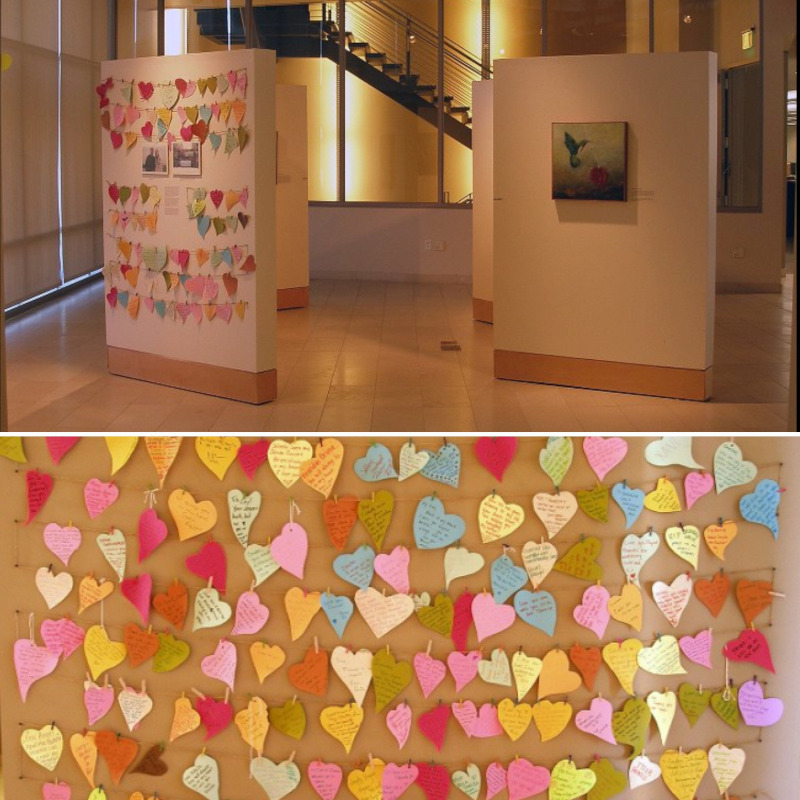
Hundreds of paper hearts on the interactive memorial walls of “Wounded Hearts,” illustrative of the personal context in the Contextual Model of Learning.
In another example of Falk and Dierking’s personal context, for “The Uterus Flag Project” (spring 2014), students joined “sit-and-stitch” workshops with artist Terrilynn Quick. These communal gatherings wove together the personal and the political. Each flag told the story of one woman’s relationship to her body; strung together, the flags represented their conversations on gender inequities, health education, and access to healthcare. One student noted: “We all came from a uterus, we all have mothers, sisters, and girlfriends.” Participants had the option of contributing their hand-stitched flags to be displayed with the project as it travels to other schools and communities.
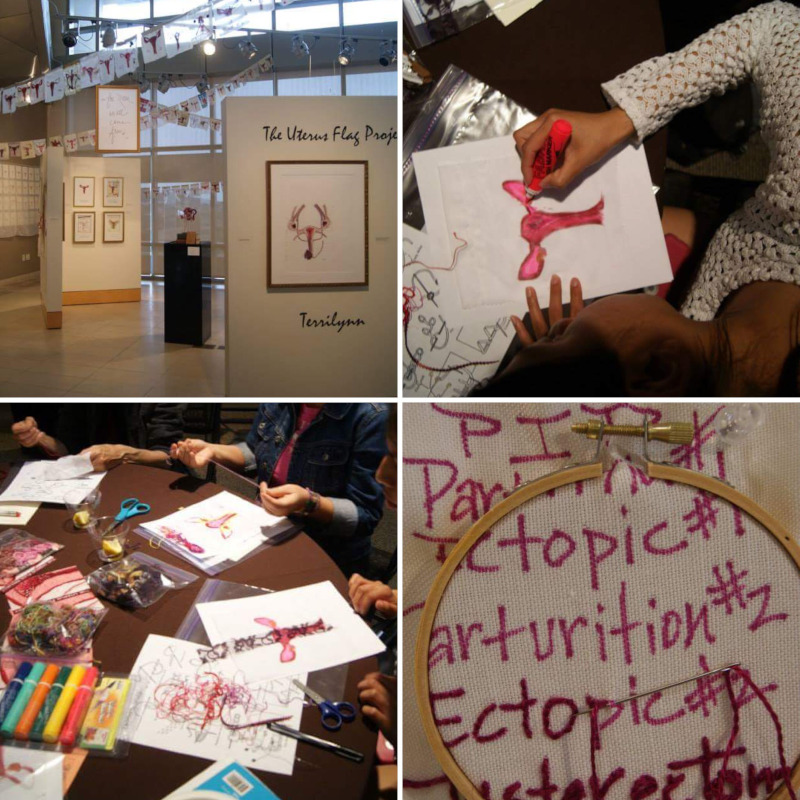
“Sit-and-stitch” workshops at the library and campus Gender Equity Center helped facilitate a sense of community and dialogue on women’s health issues.
Situating the personal within a larger perspective, Falk and Dierking’s sociocultural context is defined as “both who we perceive ourselves to be and how we perceive the world we inhabit.” ((Falk and Dierking, Learning From Museums, 39.)) Learning is a participatory process, often mediated by others and requiring engagement in the broader social world. Powerful learning opportunities can occur during a guided exhibit activity, one in which visitors (students, learners) participate productively within an installation, being able to articulate their personal interpretations of the artwork and being challenged by the viewpoints of others in a group. Ritchart argues, “Museums offer a setting in which cognition, affect, social context, and the environment are fully integrated, making them ideal places for thinking in the wild.” ((Ritchart, “Culture of Thinking,” 139.)) Social cognitive theory, used in psychology, education, communication and other disciplines, holds that portions of an individual’s knowledge acquisition can be directly related to observing others within the context of social interactions, experiences, and outside media influences. Additionally, Leinhardt and Knutson contend: “Controversy and query are two of several ways to engage visitors in connections to the learning environment.” ((Leinhardt and Knutson, Listening In, 160.)) CLS exhibit themes are certainly selected with the sociocultural context in mind, addressing issues as wide-ranging as veterans, immigration, globalization, hate crimes, migrant farm workers, the environment, and the prison industrial complex. A complete list of CLS exhibits is available on the CSUSM Library website.
An example of Falk and Dierking sociocultural context can be seen in the exhibit “Lynching in America” (fall 2004) by artist Renee Billingslee. The installation’s burned, tattered shirts, hand-stitched names of lynching victims, and patchwork quilt of authentic postcards—photos of white family picnics underneath hanging black bodies—confronted an ugly part of American history often minimized or denied in some curricula. Professor Sharon Elise guided students from the intense discussion provoked by the exhibit to researching scholarly literature and what sociologists have written on racial violence. ((Patricia M. Buckley, “Exhibit Examines Ugly History of ‘Lynching in America’,” San Diego Union Tribune (San Diego, CA), Oct. 13, 2004.)) Art exhibits exploring issues of social justice can provide relevant, thought-provoking opportunities for students to more deeply engage classroom-based curriculum.
Similarly, the “(In)Visible Project” (fall 2016) by photographer Bear Guerra engaged students in the critical sociocultural issue of homelessness. The installation’s powerful black and white photographs challenged the stigma surrounding homelessness and raised awareness of San Diego’s homeless population, fourth largest in the United States. Looping interview excerpts immersed visitors in a soundtrack voicing the dreams, happiest moments, and ideas of “home” of homeless individuals while an interactive component gave students space to answer those same questions, further connecting them to the faces and lives of the homeless portrayed in the portraits. The activity was created with questions printed on cardstock, a basket of markers, and several wall-mounted bulletin bars, an easy and affordable means of gathering student input in a library setting. A panel discussion shared regional resources and support services, including the opening of a campus food pantry, while contextualizing the local within the larger sociological forces behind housing displacement and food insecurity. A semester-long food drive, supported in part by a nearby middle school service-learning project, brought in hundreds of canned goods for a community program helping people in crisis stabilize and rebuild their lives.
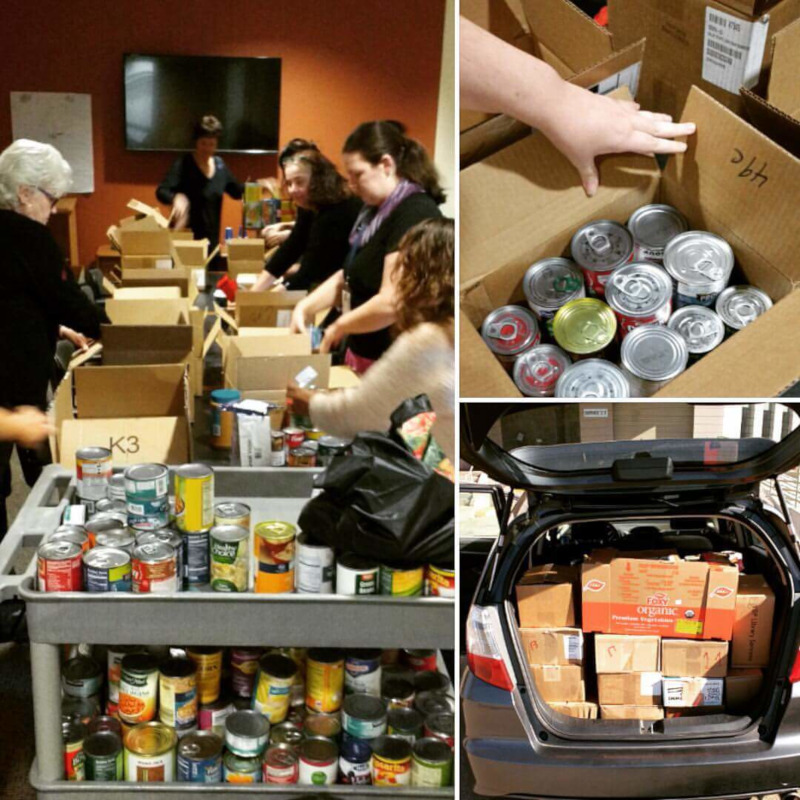
Library staff packing and delivering hundreds of canned goods to local Interfaith Community Services. The food drive was part of the CLS “(In)Visible Project” exhibit.
The third and final component of Falk and Dierking’s Contextual Model of Learning is physical context: the organization, orientation, and design elements of an installation, and the reinforcing events and experiences around the museum content. Learning and memory is very much place-dependent, inextricably bound to where the learning takes place. ((Falk and Dierking, Learning From Museums, 57.)) Per Lave and Wegner, unlike a “teaching” curriculum in which the teacher determines what knowledge should be imparted, “a learning curriculum is essentially situated.” ((Jean Lave and Etienne Wenger, Situated Learning: Legitimate Peripheral Participation (Learning in Doing) (New York: Cambridge University Press, 1991), 97.)) Situated learning occurs relative to (sometimes, in spite of) the teaching environment as learners make their own meaning, productively participating within applied and immersive experiences.
Libraries and museums in particular are places in which situated, self-directed learning takes place. Motivation is a key part of informal learning, and students and lifelong learners choose to be in these spaces. Immersed in a physical context of one’s choosing, in a space they are not necessarily required to be, students are challenged to reflect on previously held knowledge and on the assumptions of other students. Over years of various exhibit layouts, the author began to apply museum design to the library’s lobby-turned-gallery. How is the limited space maximized, augmented, delineated? How can the lighting, labels, angles of walls, and glimpses of artwork spur a sense of curiosity and wonder? Are the spaces around the artwork sufficient for wheelchair access and collaborative group work? Are there spaces to sit quietly, and spaces to gather? Are the accompanying materials informative but not overly descriptive or prescriptive? Collaborating with different artists helps to re-envision an installation space with fresh perspective each semester.
Time spent in an exhibit is one indicator of physical context on a visitor or learner. Tracking and timing methods are used to unobtrusively observe movements within an exhibit, looking for patterns to document average “dwell rate” (how long viewers spent in an exhibit, or on any one component of an exhibit) and “sweep rate” (the speed at which visitors move through an exhibit, relative to its total square footage). ((See Beverly Serrell, Paying Attention: Visitors and Museum Exhibitions (Washington, DC: American Association of Museums, 1998); Beverly Serrell, “Paying More Attention to Paying Attention,” in Informal Science, last modified July 5, 2016. http://www.informalscience.org/sites/default/files/S%26A.PA2.FinalDforCAISE2016.pdf)) Serrell acknowledges: “While we do not have the tools to measure everything that happens to a visitor in an exhibition, we do know that attention is necessary and time is an important indicator of it.” ((Beverly Serrell, “The 51% Research Project: A Meta-Analysis of Visitor Time/Use in Museum Exhibitions,” Visitor Behavior 10, no. 3 (1995): 9.)) Tracking within the physical context can be seen in the CLS exhibit “Enlisting a Nation: American Propaganda of World War I,” featuring a special collection of original propaganda posters to commemorate the 100th anniversary of World War I. After a librarian-led discussion on propaganda techniques (bandwagon, name calling, generalities, and so on), students paired up and recorded their responses to exhibit prompts on their cell phones using a free educational app called Socrative. Photographs were taken discreetly from the balcony above the library gallery to document their time spent with this activity.
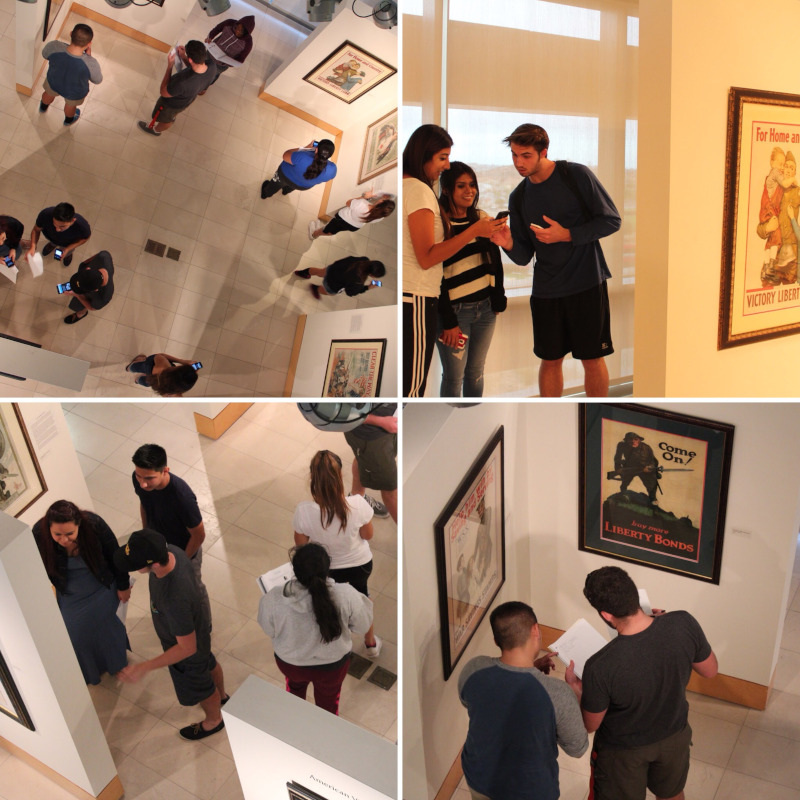
Groups of students respond to exhibit prompts on their cell phones during a guided class visit to “Enlisting a Nation” (fall 2014).
One student noted: “While looking through the library exhibit ‘Enlisting a Nation,’ I was struck by how different, yet very similar, the discourses of World War I propaganda or biased information, and current war propaganda are. In the 1910’s there was no Fox News or MSNBC to help spin and advance political discourses, although there was definitely media trying to do as such. The greatest propagandists were, and to a degree still are, the United States government.” After the library exhibit field trip, students in Professor Kymber Quinney’s history classes were then given an extra credit assignment to design what government-sponsored propaganda posters might look like today. The physical context in this case was an effective means of reinforcing and assessing student learning of the curriculum—an exhibit visit in which students worked together to describe, interpret, and evaluate the artwork on display; to compare and contrast the artwork on display with their own experiences and understanding of the world; and to apply relevant theoretical perspectives from class discussion to the exhibit. By close observation, asking questions, sharing constructive critiques, divergent thinking, and interpretations, a guided lesson within an exhibition can be an incredibly fruitful example of situational learning.
Discussion and Findings
A hallmark of the Context Library Series is close collaboration between librarians, disciplinary faculty, and artists to construct evocative, interactive lessons and components around each exhibit. This section highlights two CLS installations that exemplify the personal, sociocultural, and physical facets of Falk and Dierking’s museum-based Contextual Model of Learning.
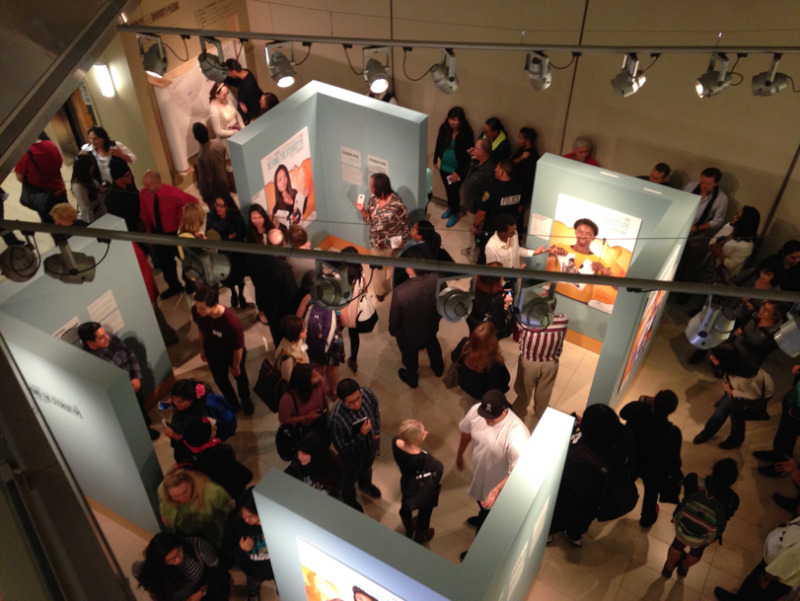
The unveiling of a student-created educational poster project at the opening of the “Beyond the Stereotype” (spring 2015) exhibit.
For the “Beyond the Stereotype” (spring 2015) exhibit, over two hundred attendees came to the opening reception to witness the unveiling of student-created, research-based posters on cultural appropriation. The poster project, created by the California Indian Culture and Sovereignty Center, featured CSUSM students ripping up stereotypical racial and ethnic costumes with the text, “There is more to me than what you see. Beyond the stereotype, there is history.” As with many CLS exhibits, participants were called to challenge their own beliefs and to take some sort of action. Visitors to the exhibit were encouraged to sign a Civility and Diversity Pledge, a commitment to examine their own biases and acknowledge the culture and humanity of others. The pledge was posted above a wall-mounted roll of butcher paper that ended up serving as a space for asynchronous dialogue on the themes of cultural appropriation. The conversation that evolved over the course of the semester included statements and responses (indicated with arrows) such as:
- “Please realize that in the process of advocating going beyond the stereotype you are actually creating one. It’s great to push past stereotypes, but please address all of them rather than choosing to portray white people as the only ones stereotyping by dressing in bad taste. THAT is creating a stereotype.”
- “It’s called cultural appropriation, not defend your whiteness!”
- “While I agree with what you’re saying, you seem to be missing the bigger picture. This exhibit focuses on stereotypes in minorities, we aren’t saying white people are the ones to stereotype. Take a step back and take another look.”
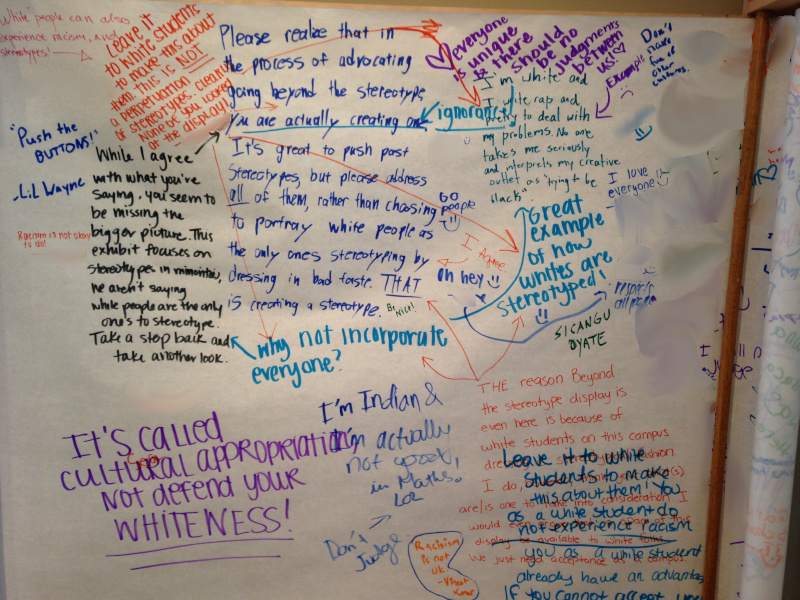
A wall-mounted roll of butcher paper provided a space for students’ thoughts, comments, and questions related to the “Beyond the Stereotype” exhibit.
The “Beyond the Stereotype” exhibit was accompanied by biographies of diverse historical and contemporary leaders to counter the negative racial and ethnic stereotypes portrayed in the posters. A series of “Conversations that Matter” workshops were organized for students, staff, and faculty on issues of cultural stereotypes, microaggressions, and bystander intervention. Professor Carolyn Sawyer used Twitter and Storify to capture the discourse related to the workshop entitled “On Bindis, Black Face, Cholos, and Cornrows.” Guided questions and activities prompted learners to situate themselves and their worldviews in response to the art installation. One student remarked: “I believe it’s hard some people to understand why they are racist because they avoid the topic #conversationsthatmatter.” The impact of this particular CLS exhibit continues as the posters and related materials are licensed by Creative Commons and available via ScholarWorks.

Overhead view of the CLS “More Than a Fence” exhibit, an interactive art installation and collaboration of CSUSM professors, students, and community.
The integration of library exhibits into the curriculum supports student research and learning in creative and compelling ways, as exemplified in the “More than a Fence: (de)Constructing Mexico/US Borders” (fall 2014) exhibit. This multimedia installation, anchored by Professor Kendra Rivera’s visual ethnography and interviews with Border Patrol agents, explored the real and symbolic effects of the border and immigration policy. Photographs and sculptural elements by community activists Maria Teresa Fernandez and Pam Calore documented the border from both sides of the fence. Students in Professor David Avalos’ Introduction to Sculpture class designed and constructed their own conceptions of the border wall: an open window next to a padlocked door; a colorful Día de los Muertos style skull adorned with flowers; a drone flying overhead, attached to wires above the library gallery. The interactive component for “More Than a Fence” was a salvaged piece of chain link fence where participants were invited to leave a thought, prayer, or inquiry. Over the course of the semester, the chain link fence was woven with hundreds of slips of paper, evoking the feeling of roadside memorials found along the border. Like “Wounded Hearts” mentioned above, these scraps of paper have been digitized in the CSUSM Institutional Repository.
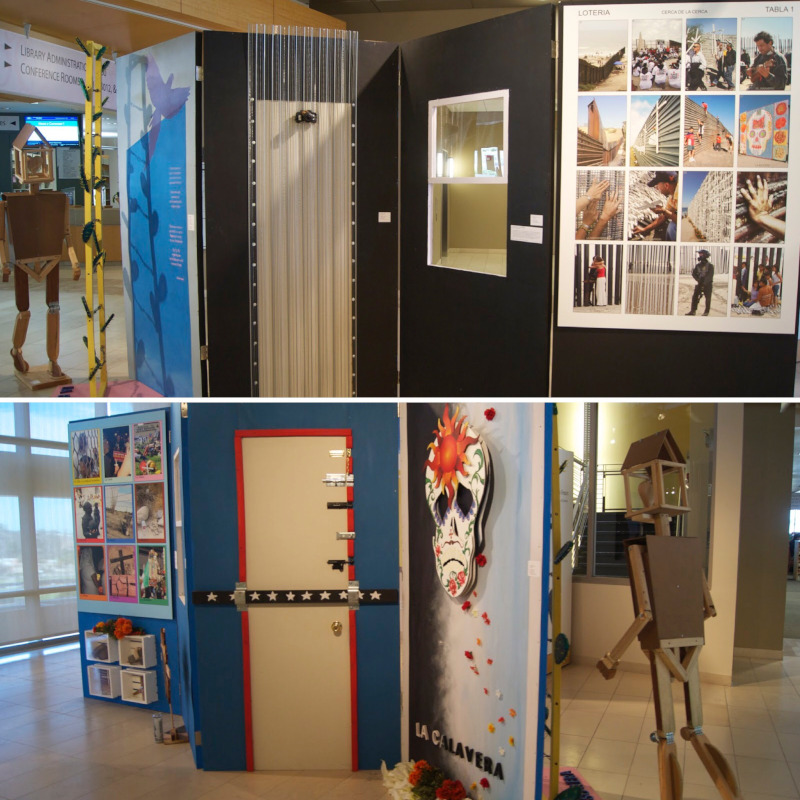
Both sides of the border fence, as envisioned and created by Introduction to Sculpture students in an intensive group research project the semester prior to the “More Than a Fence” exhibit.
Content analysis of the exhibit-generated student responses to “More Than a Fence” reveals thoughtful engagement with a difficult and complex subject matter. Indeed, the sheer volume of responses, the patterns of language, and rich dialogue that emerged over the course of the exhibit is indicative of critical thinking and student engagement.
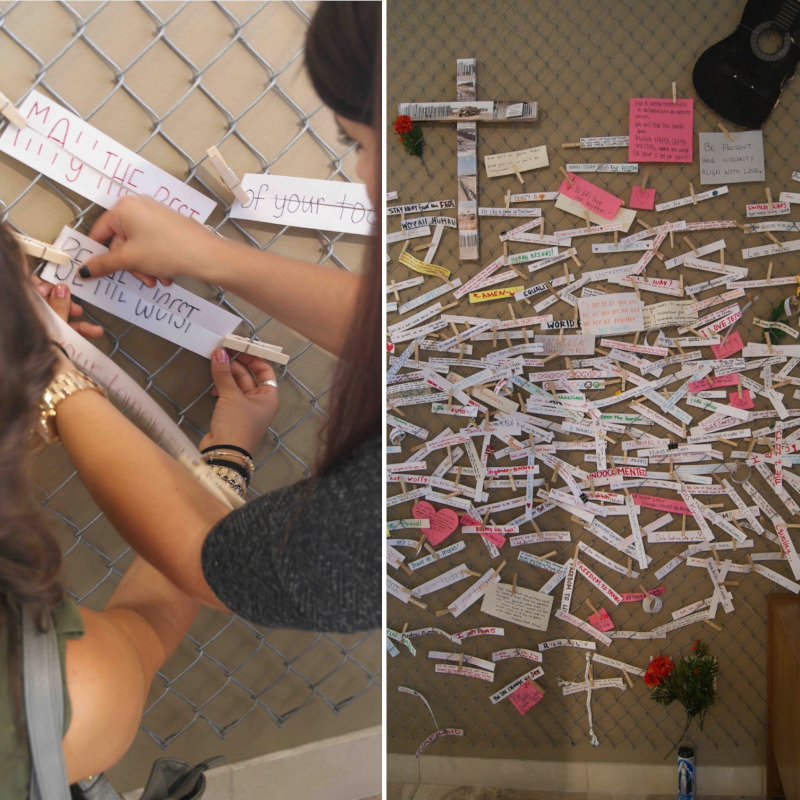
The personal, sociocultural, and physical contexts embodied in the “More Than a Fence” exhibit.
A selection of student responses ranging from the personal to sociocultural and physical contexts:
- “I always asked myself if I ever had the courage to do the same as you to find a ‘better’ life.”
- “I’m undocumented. There shouldn’t be borders to reach your dreams!”
- “I am Mexican, born in Mexico. I represent myself legally in this country. It was not hard and it’s morally correct. You should all try it rather than be proud to be illegal.”
- “People come here but not to take away anybody’s jobs. They come to do what other others don’t like to do.”
- “Yes, this world is not fair, look around. But this does not mean there is no right/wrong. The U.S. does not have the means to fix every problem.”
- “How can we expect any change to the borders on our land when we cannot remove the borders in our minds. Every one of us is an immigrant… try to remember that.”
- “We are all humans. We all bleed the same color.” – CSUSM student
- “May the love of God be with the people of both sides of the fence.”
- “Is this really the American Dream?”
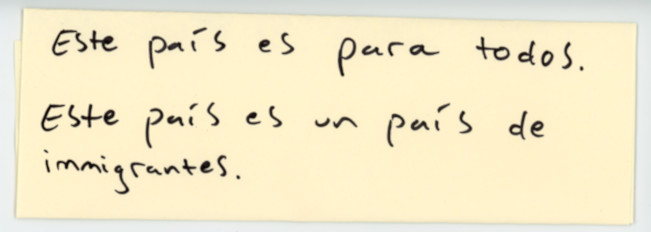
Student response to “More Than a Fence” (fall 2014), “Este país es para todos. Este país es un país de inmigrantes.” Translated: “This country is for everyone. This country is a country of immigrants.”
These findings demonstrate practical and compelling means of student experience, engagement, and learning by applying museum-based techniques. Installations such as “Beyond the Stereotype” and “More Than a Fence” challenge traditional models of art in libraries, from the rarified collections of old, to the commonplace book displays and architectural aesthetics of today.
Conclusion
As with museums, paying attention to the ways in which learning occurs in library exhibits and spaces is critical to understanding our role within in our larger educational institutions and communities. Best practices in museum and visitor studies clearly align with the library’s work of engaging students as we cultivate the habits of mind of lifelong learners. Both museums and libraries facilitate dynamic experiential learning by providing: spaces for personal reflection and meaning making, for self-directed exploration and guided class activities; opportunities for dialogue, debate, and connection; calls to action and productive participation; access to thought-provoking, relevant content and to multimedia, multimodal experiences; and more. The field of museum studies, in particular Falk and Dierking’s framework, gives librarians a new way to articulate and amplify the impact we have on student learning.
By examining the Context Library Series through the museum-based Contextual Model of Learning, we see how academic libraries move from a peripheral role to one at the heart and intersection of the personal, sociocultural, and physical contexts of learning. Illustrated with specific CLS examples throughout this case study, we witness time and again the transformative impact of re-envisioning common learning spaces and re-interpreting curricularly driven displays. Libraries provide context: the people, space, and resources that help students make sense of their world, that help them formulate questions and find answers, that support their inquiry and curiosity. Librarians, as mediators of curriculum and curators of collections, can further adapt museum-based practices to transform our common learning spaces, exhibits, and instructionally related programs.
Acknowledgements
I am forever grateful to my colleagues and mentors at the CSUSM Library, for taking a chance on a librarian right out of grad school, for supporting my vision for the Context Library Series, and for helping me literally move (exhibit) walls. Thank you to the students and staff of the Instructionally Related Activities committee who renewed CLS grant funds year after year. To all the incredible artists and faculty collaborators I’ve had the honor of working with, too many to name here, thank you. Shout out to Kristin Moss for being my guide through all things art; to Kate Crocker, for your brilliance and for holding me up (on ladders, and thru good times and bad); and to Carmen Mitchell, an exceptional librarian, friend, and the reason CLS exhibits live on in ScholarWorks. Lastly, my sincere thanks to peer-reviewers Amy Koester and Stacy Williams, publishing editor Ian G. Beilin, and web editor Ryan Randall, for their thoughtful feedback and recommendations on this article.
References
Bitgood, Steven, and Harris H. Shettel. “An Overview of Visitor Studies.” Journal of Museum Education 21, no. 3 (November 2015): 6-10.
Bosma, Josephine. “Art as Experience: Meet the Active Audience.” In Network Art: Practices and Positions. Tom Corby, ed. 24-39. New York: Routledge, 2006.
Boylan, Patrick J. “Universities and Museums: Past, Present and Future.” Museum Management and Curatorship 18, no. 1 (1999): 43-56.
Brown, Mary E. and Rebecca Power. Exhibits in Libraries: A Practical Guide. Jefferson, NC: McFarland, 2006.
Buckley, Patricia M. “Exhibit Examines Ugly History of ‘Lynching in America’.” San Diego Union Tribune (San Diego, CA). Oct. 13, 2004.
California State University San Marcos. “WASC Institutional Report.” Last modified Sept. 9, 2015.
http://www.csusm.edu/wasc/institutionalreport.html
Chi, Michelene T.H., and Rod D. Roscoe. “The Processes and Challenges of Conceptual Change.” In Reconsidering Conceptual Change: Issues in Theory and Practice. Margarita Limon and Lucia Mason, eds. 3-27. Netherlands: Springer, 2007.
DeBacker, Free, Jeltsen Peeters, Tine Buffel, Ankelien Kindekens, Veronique Romero Reina, Willem Elias, and Koen Lombaerts. “An Integrative Approach for Visual Arts Mediation in Museums.” Procedia – Social and Behavioral Sciences 143 (2014): 743-49.
Dutka, Andrew, Sherman Hayes, and Jerry Parnell. “The Surprise Part of a Librarian’s Life: Exhibition Design and Preparation Course.” College & Research Library News 63, no. 1 (2002): 19-22.
Falk, John H., and Lynn D. Dierking. Learning From Museums: Visitor Experiences and the Making of Meaning. Walnut Creek, CA: Altamira Press, 2000.
Fletcher, Jennifer. “Critical Habits of Mind: Exposing the Process of Development.” Liberal Education 99, no. 1 (Winter 2013).
Kam, D. Vanessa. “On Collecting and Exhibiting Art Objects in Libraries, Archives, and Research Institutes.” Art Documentation: Bulletin of the Art Libraries Society of North America 20, no. 2 (2001): 10-15.
Lave, Jean, and Etienne Wenger. Situated Learning: Legitimate Peripheral Participation (Learning in Doing). New York: Cambridge University Press, 1991.
Leinhardt, Gaea and Karen D. Knutson. Listening In on Museum Conversations. Walnut Creek, CA: Altamira Press, 2004.
Paul, Christiane, ed. New Media in the White Cube and Beyond: Curatorial Models for Digital Art. Berkeley: University of California Press, 2008.
Pinus, Diana A. “Look Again! Planning an Exhibition with Social Interaction in Mind.” Journal of Museum Education 25, no. 1/2 (2000): 21-24.
Ritchart, Ron. “Cultivating a Culture of Thinking in Museums.” Journal of Museum Education 32, no. 2 (2007): 137-53.
Schwager, Tim. “Mirrors and Memories: How Libraries Connect with Their Communities.”
Australian Library Journal 47, no. 1, 83-90. doi: 10.1080/00049670.1998.10755835
Schweickart, Patrocinio P., and Elizabeth A. Flynn, eds. Reading Sites: Social Difference and Reader Response. New York: Modern Language Association of America, 2004.
Serrell, Beverly. “The 51% Research Project: A Meta-Analysis of Visitor Time/Use in Museum Exhibitions.” Visitor Behavior 10, no. 3 (1995): 5-9.
Serrell, Beverly. Paying Attention: Visitors and Museum Exhibitions. Washington, DC: American Association of Museums, 1998.
Serrell, Beverly. “Paying More Attention to Paying Attention.” Informal Science.
Last modified July 5, 2016. http://www.informalscience.org/sites/default/files/S%26A.PA2.FinalDforCAISE2016.pdf
Simmons, Michelle H. “Librarians as Disciplinary Discourse Mediators: Using Genre Theory to Move Toward Critical Information Literacy.” portal: Libraries and the Academy 5, no. 3 (2005): 297-311.
Stromberg, John R. “Creativity and the Relevant Museum: A Proposal.” In A Handbook for Academic Museums: Exhibitions and Education. Stefanie S. Jandl and Mark S. Gold, eds. 20-35. Boston: Museums Etc, 2012.
Swanick, Sean, Sharon Rankin, and Melinda Reinhart. “Curating Exhibitions in Academic Libraries: Practical Steps.” Practical Academic Librarianship 5 (2015): 1-22.
Teller, Alan. “Assessing Excellence in Exhibitions: Three Approaches.” Exhibitionist Journal 26, no. 2 (Fall 2007): 69-75.
Van Deusen, Jean D. “The School Library Media Specialist as a Member of the Teaching Team: ‘Insider’ and ‘Outsider.’” Journal of Curriculum & Supervision 11, no. 3 (1996): 229-48.
Worts, Douglas. “Transformational Encounters: Reflections on Cultural Participation and Ecomuseology.” Canadian Journal of Communication 31, no. 1 (2006).
